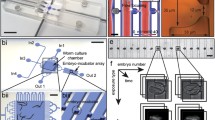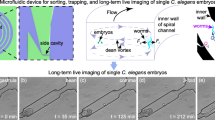Abstract
Caenorhabditis elegans has been an essential model organism in the fields of developmental biology, neuroscience, and aging. However, these areas have been limited by our ability to visualize and track individual C. elegans worms, especially at the subcellular scale, over the course of their lifetime. Here we present a microfluidic device to culture individual C. elegans in parallel throughout post-embryonic development. The device allows for periodic mechanical immobilization of the worm, enabling 3D imaging at subcellular precision. The immobilization is sufficient to enable fluorescence recovery after photobleaching (FRAP) measurements on organelles and other substructures within the same specific cells throughout larval development, without the use of chemical anesthetics. Using this device, we measure FRAP recovery of two nucleolar proteins in specific intestinal cells within the same worms during larval development. We show that these proteins exhibit different fluorescence recovery as the worm grows, suggesting differential protein interactions during development. We anticipate that this device will help expand the possible uses of C. elegans as a model organism, enabling its use in addressing fundamental questions at the subcellular scale.





Similar content being viewed by others
References
Abate AR, Thiele J, Weitz DA (2011) One-step formation of multiple emulsions in microfluidics. Lab Chip 11:253–258. doi:10.1039/C0LC00236D
Berry J, Weber SC, Vaidya N et al (2015) RNA transcription modulates phase transition-driven nuclear body assembly. Proc Natl Acad Sci 112:E5237–E5245. doi:10.1073/pnas.1509317112
Blair D, Dufresne E (2007) The MATLAB particle tracking code repository. http://physics.georgetown.edu/matlab/
Bodri MS (2011) Nematodes. In: Lewbart GA (ed) Invertebrate Medicine, 2nd edn. Wiley-Blackwell, Oxford, UK. doi:10.1002/9780470960806.ch18
Brangwynne CP (2013) Phase transitions and size scaling of membrane-less organelles. J Cell Biol 203:875–881. doi:10.1083/jcb.201308087
Brangwynne CP, Eckmann CR, Courson DS et al (2009) Germline P granules are liquid droplets that localize by controlled dissolution/condensation. Science 324:1729–1732
Brangwynne CP, Tompa P, Pappu RV (2015) Polymer physics of intracellular phase transitions. Nat Phys 11:899–904. doi:10.1038/nphys3532
Chokshi TV, Ben-Yakar A, Chronis N (2009) CO2 and compressive immobilization of C. elegans on-chip. Lab Chip 9:151–157. doi:10.1039/b807345g
Chung K, Crane MM, Lu H (2008) Automated on-chip rapid microscopy, phenotyping and sorting of C. elegans. Nat Methods 5:637–643. doi:10.1038/nmeth.1227
Crocker J, Grier D (1996) Methods of digital video microscopy for colloidal studies. J Colloid Interface Sci 179:298–310. doi:10.1006/jcis.1996.0217
Feric M, Vaidya N, Harmon TS et al (2016) Coexisting liquid phases underlie nucleolar subcompartments. Cell 165:1686–1697. doi:10.1016/j.cell.2016.04.047
Gilleland CL, Rohde CB, Zeng F, Yanik MF (2010) Microfluidic immobilization of physiologically active Caenorhabditis elegans. Nat Protoc 5:1888–1902. doi:10.1038/nprot.2010.143
Guo SX, Bourgeois F, Chokshi T et al (2008) Femtosecond laser nanoaxotomy lab-on-a-chip for in vivo nerve regeneration studies. Nat Methods 5:531–533. doi:10.1038/nmeth.1203
Hope IA (1999) C. elegans: A Practical Approach. Oxford University Press, Oxford
Hulme SE, Shevkoplyas SS, Apfeld J et al (2007) A microfabricated array of clamps for immobilizing and imaging C. elegans. Lab Chip 7:1515–1523. doi:10.1039/B707861G
Hyman AA, Weber CA, Jülicher F (2014) Liquid-liquid phase separation in biology. Annu Rev Cell Dev Biol 30:39–58. doi:10.1146/annurev-cellbio-100913-013325
Keil W, Kutscher LM, Shaham S, Siggia ED (2016) Long-term high-resolution imaging of developing C. elegans larvae with microfluidics. Dev Cell. doi:10.1016/j.devcel.2016.11.022
Kenyon C, Chang J, Gensch E et al (1993) A C. elegans mutant that lives twice as long as wild type. Nature 366:461–464
Kim E, Sun L, Gabel CV, Fang-Yen C (2013) Long-term imaging of Caenorhabditis elegans using nanoparticle-mediated immobilization. PLoS ONE 8:1–6. doi:10.1371/journal.pone.0053419
Lee CF, Brangwynne CP, Gharakhani J et al (2013) Spatial organization of the cell cytoplasm by position-dependent phase separation. Phys Rev Lett 111:88–101. doi:10.1103/PhysRevLett.111.269902
McDonald JC, Whitesides GM (2002) Poly(dimethylsiloxane) as a material for fabricating microfluidic devices. Acc Chem Res 35:491–499. doi:10.1021/ar010110q
Mondal S, Ahlawat S, Koushika SP (2012) Simple microfluidic devices for in vivo imaging of C. elegans, Drosophila and Zebrafish. J Vis Exp 2025:1–9. doi:10.3791/3780
Nawa M, Matsuoka M (2012) The method of the body bending assay using Caenorhabditis elegans. Bio-Protocol. doi:10.21769/BioProtoc.253
Nicolas G, Sillans D (1989) Immediate and latent effects of carbon dioxide on insects. Annu Rev Entomol 34:97–116. doi:10.1146/annurev.ento.34.1.97
Phair RD, Gorski SA, Misteli T (2004) Measurement of dynamic protein binding to chromatin in vivo, using photobleaching microscopy. Meth Enzymol 375:393–414
Podbilewicz B, Gruenbaum Y (2006) Live imaging of Caenorhabditis elegans: preparation of samples. Cold Spring Harb Protoc. doi:10.1101/pdb.prot4601
Rafelski SM, Viana MP, Zhang Y et al (2012) Mitochondrial network size scaling in budding yeast. Science 338:822–824
Rohde CB, Zeng F, Gonzalez-Rubio R et al (2007) Microfluidic system for on-chip high-throughput whole-animal sorting and screening at subcellular resolution. Proc Natl Acad Sci 104:13891–13895. doi:10.1073/pnas.0706513104
Sulston JE, Horvitz HR (1977) Post-embryonic cell lineages of the nematode, Caenorhabditis elegans. Dev Biol 56:110–156. doi:10.1016/0012-1606(77)90158-0
Sulston JE, Schierenberg E, White JG, Thomson JN (1983) The embryonic cell lineage of the nematode Caenorhabditis elegans. Dev Biol 100:64–119. doi:10.1016/0012-1606(83)90201-4
Tabara H, Grishok A, Mello CC (1998) RNAi in C. elegans: soaking in the genome sequence. Science 282:430–431
Timmons L, Fire A (1998) Specific interference by ingested dsRNA. Nature 395:854
Timmons L, Court DL, Fire A (2001) Ingestion of bacterially expressed dsRNAs can produce specific and potent genetic interference in Caenorhabditis elegans. Gene 263:103–112. doi:10.1016/S0378-1119(00)00579-5
Uppaluri S, Brangwynne CP (2015) A size threshold governs Caenorhabditis elegans developmental progression. Proc R Soc B. doi:10.1098/rspb.2015.1283
Valm AM, Cohen S, Legant WR et al (2017) Applying systems-level spectral imaging and analysis to reveal the organelle interactome. Nature 546:162–167
Wang JT, Smith J, Chen B-C et al (2014) Regulation of RNA granule dynamics by phosphorylation of serine-rich, intrinsically disordered proteins in C. elegans. Elife 3:e04591. doi:10.7554/eLife.04591
Weber SC, Brangwynne CP (2015) Inverse size scaling of the nucleolus by a concentration-dependent phase transition. Curr Biol 25:641–646. doi:10.1016/j.cub.2015.01.012
Zhang B, Xiao R, Ronan EA et al (2015) Environmental temperature differentially modulates C. elegans longevity through a thermosensitive TRP channel Bi. Cell Rep 11:1414–1424. doi:10.1158/1078-0432.CCR-15-0428.Bioactivity
Zhu L, Brangwynne CP (2015) Nuclear bodies: the emerging biophysics of nucleoplasmic phases. Curr Opin Cell Biol 34:23–30
Acknowledgements
We would like to thank Carlos Chen and the members of the C. P. B. laboratory for helpful discussions. We also thank Saurabh Vyawahare at the Princeton Microfluidics Facility. Some strains were provided by the CGC, which is funded by the NIH Office of Research Infrastructure Programs (P40 OD010440). This work was supported by the NIH Director’s New Innovator Award (1DP2GM105437-01) and the Searle Scholars Program (12-SSP-217). J. S. was supported in part by Princeton University’s Lidow Senior Thesis Fund.
Author information
Authors and Affiliations
Corresponding author
Electronic supplementary material
Below is the link to the electronic supplementary material.
Rights and permissions
About this article
Cite this article
Shivers, J., Uppaluri, S. & Brangwynne, C.P. Microfluidic immobilization and subcellular imaging of developing Caenorhabditis elegans . Microfluid Nanofluid 21, 149 (2017). https://doi.org/10.1007/s10404-017-1988-2
Received:
Accepted:
Published:
DOI: https://doi.org/10.1007/s10404-017-1988-2




